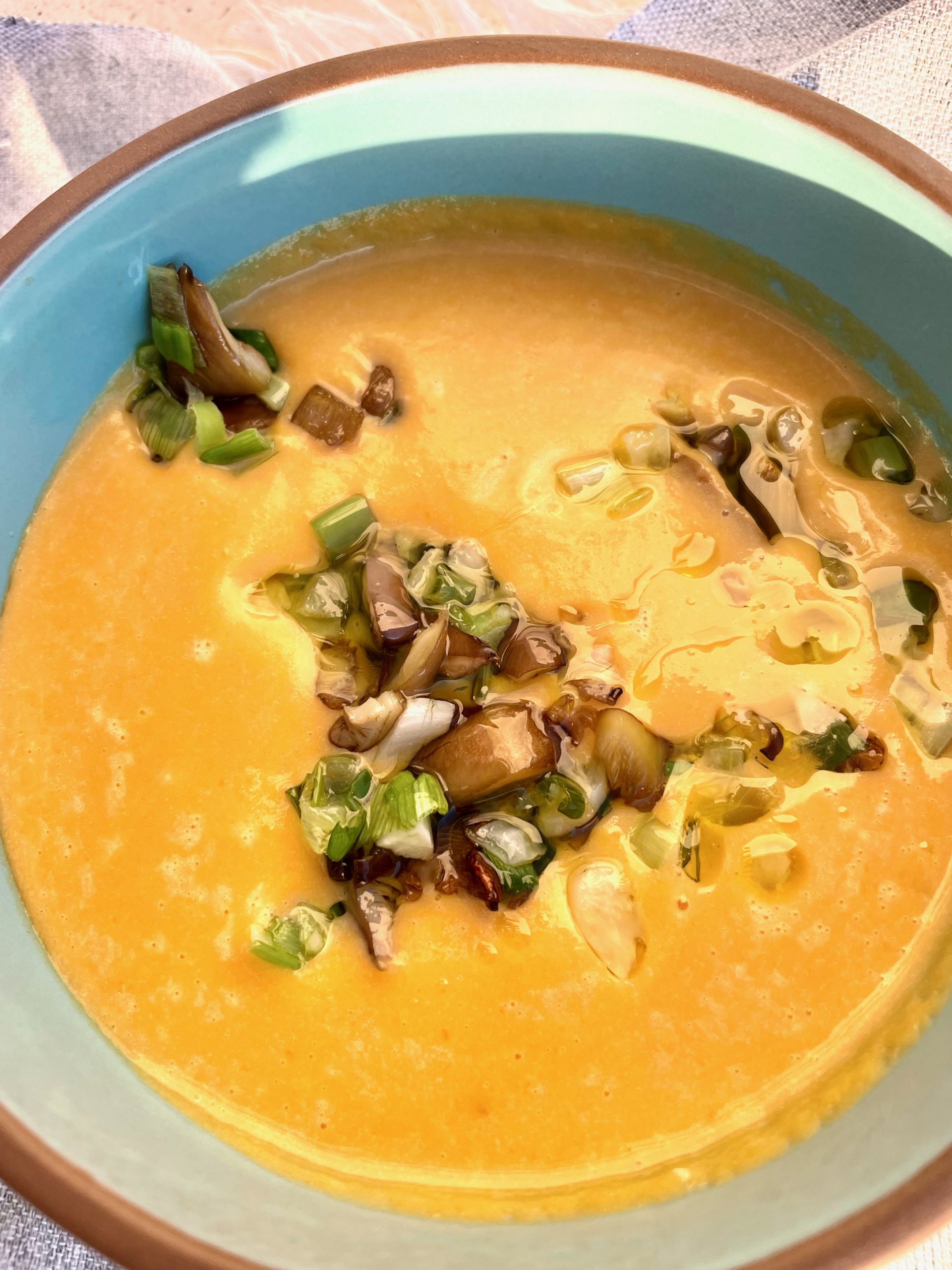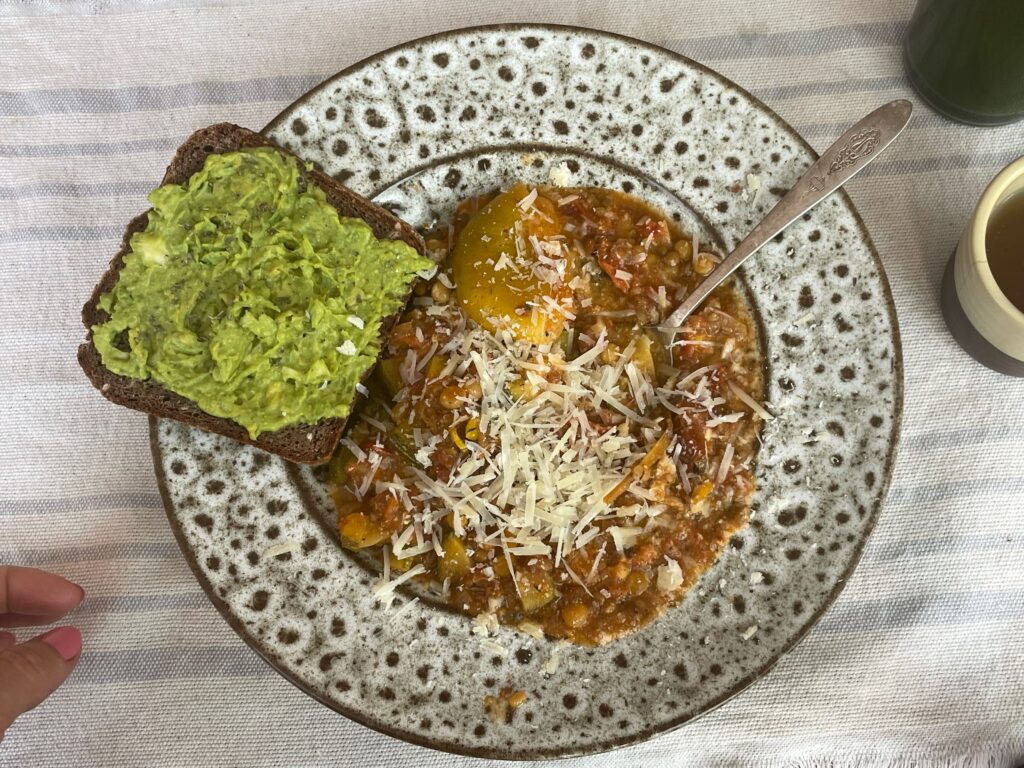
Compared to the majority of other vegetables, tomatoes are not high in nutrients other than vitamin A with 900 IU per cup. A cup of tomatoes contributes small amounts (10%) of a persons daily needs for calcium and vitamin C. Zucchini are another vegetable that is not extremely high in one certain nutrient, but have 5-9% of almost every nutrient. Zucchini is high in vitamin C and vitamin B6. One serving of this dish has only about 338 calories and is high in thiamine, B6, folate, vitamin C, zinc, and iron.
The thiamine in this dish comes from the combination of the peas, lentils, and sunflower or pumpkin seeds that are added at the end. Thiamine is a crucial nutrient in one carbon metabolism and the Krebs Cycle which is your main metabolic cycle for burning the nutrients that you consume.
Observations on Modern Diets
Walking down a tree-lined avenue in an old colonial neighborhood I was pondering the unhealthy dietary habits of people. Then, I saw large cloth bags of flour outside a bakery labeled with iron, zinc, folate, and thiamine. This made me realize that many people are still nutrient-deficient despite eating large amounts of food. The reason? They are consuming synthetic nutrients, which the body struggles to absorb and utilize effectively. Unlike natural nutrients, synthetic forms often lack the necessary cofactors that aid in absorption and utilization. The human body has evolved to process nutrients in their natural forms over thousands of years, and this sudden reliance on synthetic nutrients cannot replicate the same health benefits.
This problem significantly contributes to the obesity epidemic. Even if synthetic nutrients are consumed in quantities matching those in natural foods, their efficiency is diminished by the body’s inability to use them properly. Processed foods often lack the full spectrum of nutrients found in whole foods. As a result, people cannot effectively metabolize the macronutrients in processed foods, leading to energy deficits, excess fat storage, and persistent hunger.

Lack of thiamine can cause you to store too much fat, feel tired, and be depressed
If you want to burn more fat, efficiently utilize the calories you consume, and have more energy, ensuring optimal thiamine levels is essential. Thiamine not only aids in energy metabolism but also plays a role in preventing depression. Those with higher muscle mass or who engage in weightlifting, as well as individuals with a mesomorph body type, need higher amounts of thiamine.
Your body’s ability to utilize food efficiently directly impacts your energy levels. Properly metabolizing the fuel you consume is crucial. Often, overweight individuals continue to feel hungry despite consuming large quantities of food because they are not getting enough micronutrients, that is vitamins and minerals. This micronutrient deficiency drives them to eat more, seeking the nutrients their bodies crave. This issue is compounded by excessive macronutrient intake and dysregulated hormonal signals, such as ghrelin and leptin, which control hunger and satiety.
Furthermore, lack of thiamine will inhibit the oxidation of fat (burning of fats) (beta-oxidation of fatty acids) which will result in more of your body fat staying as body fat. Lack of thiamine also inhibits the body from burning the fats, carbohydrates, and proteins from foods you eat, resulting in their storage rather than utilization for fuel. This is why you can have an excess of calories, but still feel sluggish, among other reasons.

The Solution: High Micronutrient-to-Macronutrient Ratio is Required for Weight Loss
To counteract these issues, it is essential to consume foods with a high micronutrient-to-macronutrient ratio. For example, a Zucchini Summer Stew recipe provides nearly 25% or more of half the essential micronutrients needed, along with significant amounts of other nutrients, all within less than 400 calories. This ratio, offering more than a quarter of essential nutrients in 20% of daily caloric intake, is noteworthy. The thiamine content in this meal is 1 mg per serving (400 calories), which meets 83-90% of the daily requirements for men and women, respectively, and 71% for pregnant or breastfeeding women. In contrast, a traditional fried chicken sandwich provides a similar amount of thiamine but with the consumption of 1,200 calories. If your goal is to lose weight, this will not happen unless you have a high micronutrient intake.
Practical Tips for Sustaining Thiamine Levels and Preventing Depression
To maintain adequate thiamine levels, incorporate staple foods rich in this nutrient into your diet regularly. For example, I addressed my riboflavin deficiency and anemia by eating sprouted almonds as snacks. I choose this food because almonds also contain high amounts of biotin which prevent me from hair loss. Similarly, consuming brown rice and raw coconut daily can significantly improve energy metabolism due to their high thiamine content. Depression is caused by a variety of nutrient deficiencies, thiamine is one of them.
By prioritizing nutrient-dense foods, you can enhance energy levels, support metabolic health, and reduce cravings driven by nutrient deficiencies. The best supplement for thiamine is to prioritize high thiamine foods because the body can effectively use this type of thiamine. Thiamine is found in high levels in whole grains, such as teff, buckwheat, stoneground cornmeal, sorghum and brown rice. Instead of taking a supplement for thiamine for depression you should start baking the bread recipes on this blog to improve your nutritional intake.
Beans, nuts, and lentils are among the highest thiamine-containing foods. You should consume at least two servings of legumes a day and you will obtain 70% of your daily thiamine. For example In the legume family, split peas, navy beans, black beans, and tofu have the highest thiamine levels, providing 0.5 mg or 35% of thiamine in a 1 1/4 cup serving. Navy beans are also super high in iron. They are only surpassed by soybeans, edamame, or soy milk. The next highest quantities of thiamine can be found in pinto beans, kidney beans, mung beans, and lentils, which contain 0.375 mg per 1 1/4 cup.
Points for Pregnancy and Lactation
- Increased Needs in the Third Trimester: Nutritional requirements escalate significantly during the third trimester.
- Increased Needs if Active: Greater physical activity and exercise demand higher nutritional intake.
- Mesomorph Body Type: Individuals with a mesomorph body type may require higher nutrient levels due to increased muscle mass.
- Extrapolated Needs: Nutritional needs during pregnancy and lactation are often determined by extrapolating adult requirements and increasing them by a factor of 1.2.

Summer Stew
Equipment
- 1 4 quart + stainless pot
Ingredients
Saute:
- 1/3 c ghee
- 1 large onion or 2 medium until translucent
Add spices
- 1/4 t fenugreek
- 1/4 t mustard seeds
- 1/4 t cumin seeds
Add and cook down till mushy:
- 7 Roma tomatos
- 3/4 t curry powder
Add:
- 2 liters of water
- 1/4 t saffron
- 1 nice sized lemongrass stalk tied in a bow
- 1/4 c fresh or dried peas
- 1/3 c dry lentils that have been soaked at least 3-5 hrs in filtered water
Simmer on low for 45 minutes.
Last 15 min add 2 T amaranth
Turn off heat.
15-20 minutes before serving add
- 4 small zucchinis diced (about 3 cups loosely packed)
- 1/2 organic lemon squeeze out juice and throw in rind
- 1 t salt
Cook down until still bright green, but softened
- 1 c sunflower seeds toast separately in a small skillet, add to top
Notes
Really good with fresh organic cream or a soft goat cheese topped on it.

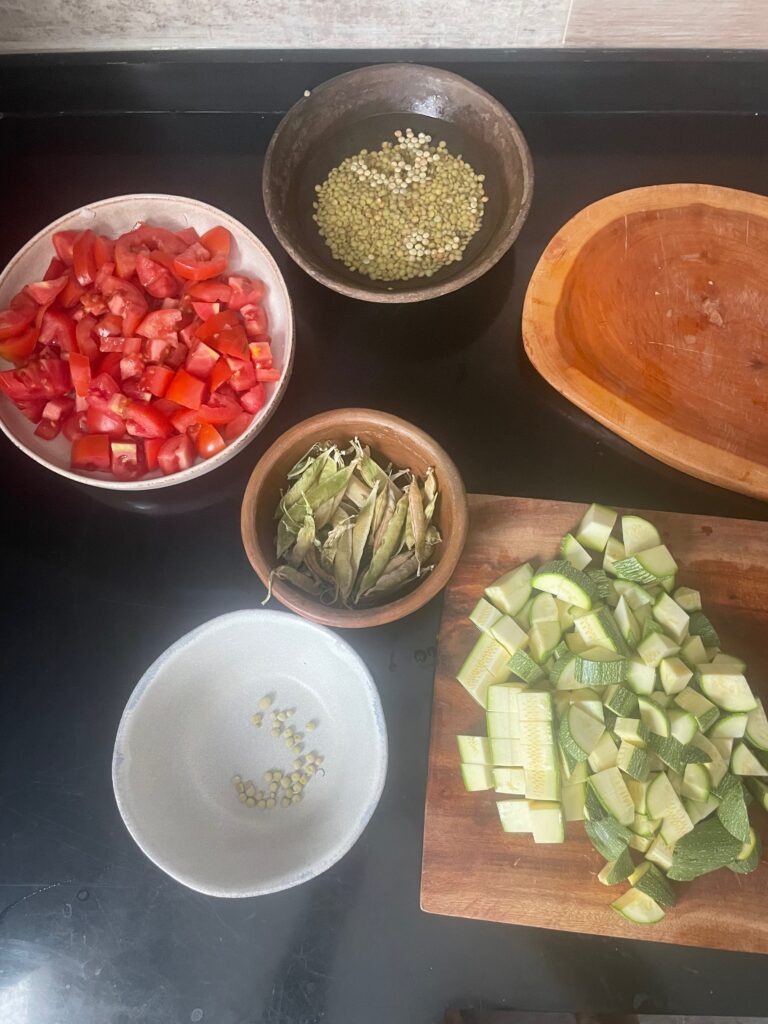
Saute:
1/3 c ghee
1 large onion or 2 medium until translucent
Add spices
1/4 t fenugreek
1/4 t mustard seeds
1/4 t cumin seeds
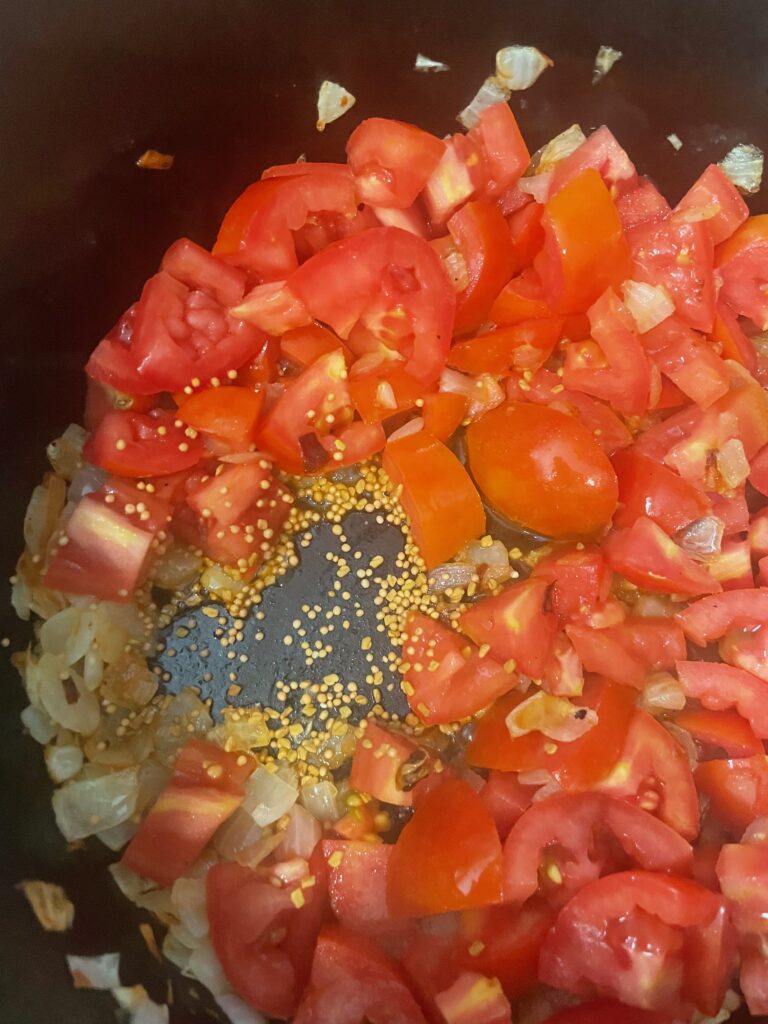
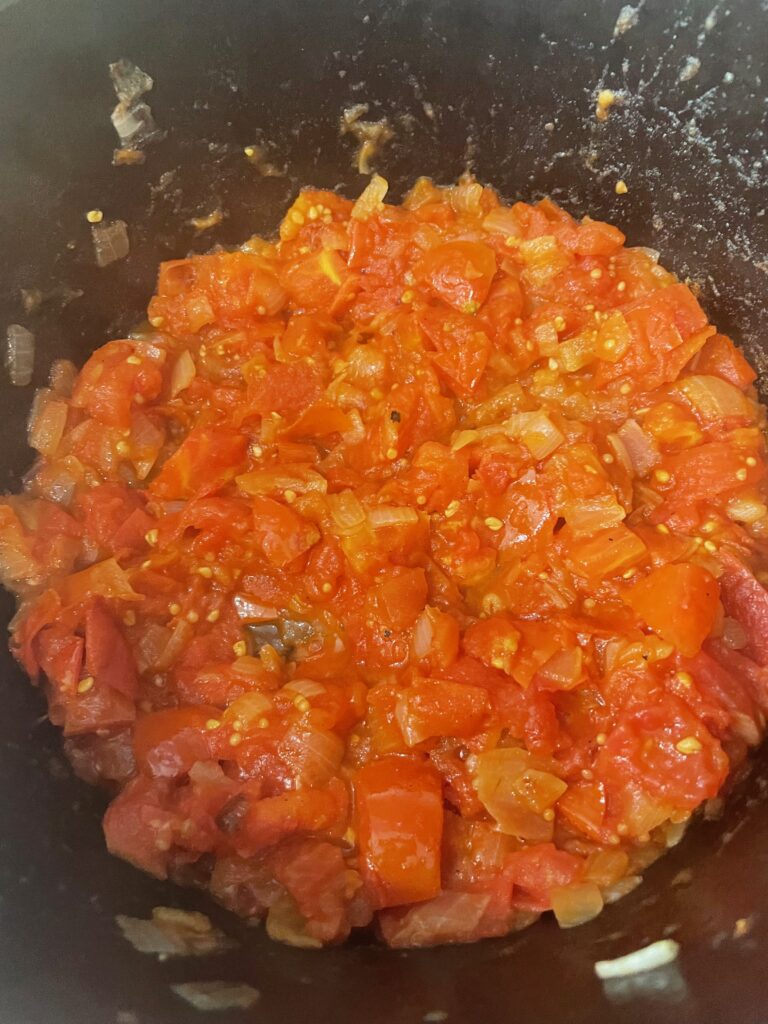

Add and cook down till mushy:
7 Roma tomatos
3/4 t curry powder





Add:
2 liters of water
1/4 t saffron
1 nice sized lemongrass stalk, tied in a bow
1/4 c fresh or dried peas
1/3 c dry lentils that have been soaked at least 3-5 hrs in filtered water
Simmer on low for 45 minutes.
Last 15 min add 2 T amaranth
Turn off heat.
15-20 minutes before serving add
4 small zucchinis, diced (about 3 cups loosely packed)
1/2 organic lemon, squeeze out juice and throw in rind
1 t salt
Cook down until still bright green, but softened
Serve topped with plenty of fresh cheese or a cashew cream sauce, or a tablespoon of brewers yeast for a vegan is an easy option. Toasted pumpkin seeds are excellent on top and make a complete protein as the amino acids in seeds complement the amino acids in beans. This means they make a complete protein, just like meat.
Serve with old homemade bread fried in ghee or Teff Crackers. Top each serving with 2 T of toasted sunflower seeds to reach the full thiamine content provided.
| Nutrient | Amount | %DV |
|---|---|---|
| Fat | 16.8 g | 21.54% |
| Saturated Fat | 5.6 g | 28.00% |
| Trans Fat | 0 g | 0.00% |
| Monounsaturated Fat | 4.0 g | 20.00% |
| Polyunsaturated Fat | 6.0 g | 30.00% |
| Carbohydrates | 40.0 g | 14.55% |
| Fiber | 5.6 g | 20.00% |
| Total Sugars | 6.0 g | 12.00% |
| Added Sugars | 2.0 g | 4.00% |
| Protein | 5.6 g | 11.20% |
| Cholesterol | 0 mg | 0.00% |
| Sodium | 90 mg | 3.91% |
| Calcium | 40 mg | 3.08% |
| Magnesium | 20 mg | 4.76% |
| Potassium | 300 mg | 6.38% |
| Iron | 1.8 mg | 10.00% |
| Zinc | 0.8 mg | 7.27% |
| Phosphorus | 70 mg | 10.00% |
| Vitamin A | 180 µg | 20.00% |
| Vitamin C | 12 mg | 13.33% |
| Thiamine (B1) | 1 mg | 86% |
| Riboflavin (B2) | 0.156 mg | 12.00% |
| Niacin (B3) | 1.794 mg | 11.21% |
| Vitamin B6 | 0.2272 mg | 13.36% |
| Folate (Equivalent) | 36 µg | 9.00% |
| Folate (Food) | 32 µg | 8.00% |
| Vitamin B12 | 0 µg | 0.00% |
| Vitamin D | 0 µg | 0.00% |
| Vitamin E | 2 mg | 13.33% |
| Vitamin K | 18 µg | 15.00% |
| Iodine | 0 µg | 0.00% |
| Selenium | 7.64 µg | 13.89% |
| Biotin | 5.594 µg | 18.65% |
| Choline | 30.06 mg | 5.47% |







